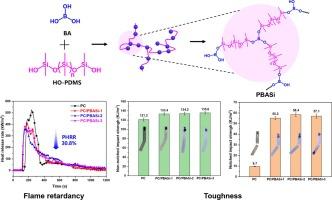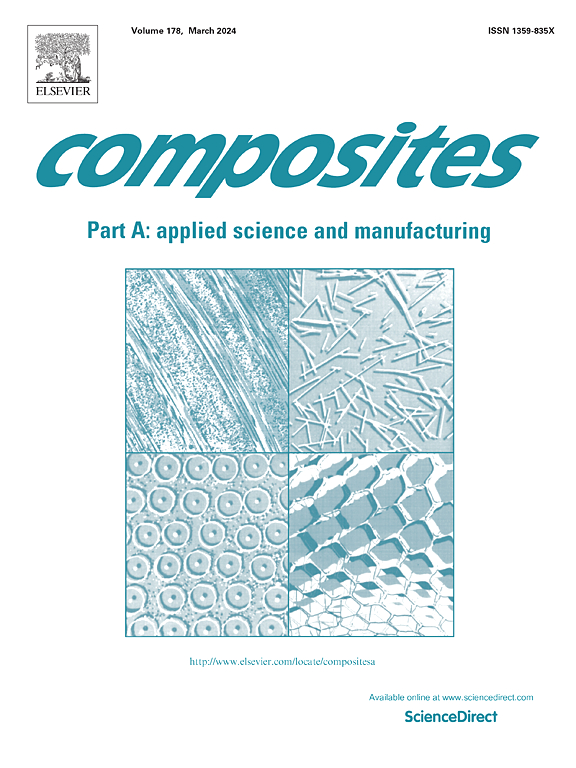通过聚硼硅氧烷弹性体的反应共混制备阻燃增韧聚碳酸酯
IF 8.1
2区 材料科学
Q1 ENGINEERING, MANUFACTURING
Composites Part A: Applied Science and Manufacturing
Pub Date : 2024-10-01
DOI:10.1016/j.compositesa.2024.108505
引用次数: 0
摘要
在实际应用中,对 PC 的阻燃和增韧性能的需求引起了研究人员的广泛关注。本文采用环保方法合成了聚硼硅氧烷弹性体(PBASi),并通过反应共混将其加入到 PC 中。加入 2 wt% 的 PBASi 后,PC 达到了 UL-94V-0 级,LOI 值为 30.4%。与纯 PC 相比,PBASi 的加入还使峰值热释放率和总烟雾产生量分别降低了 30.8% 和 29.7%。PC 和 PBASi 之间形成的海岛结构以及混合过程中在它们的界面上发生的酯交换反应提高了相容性。PBASi 可减轻 PC 的缺口敏感性,与纯 PC 相比,断裂伸长率提高了 58.8%,缺口冲击强度提高了 502.1%。这些结果表明,PBASi 在为工业应用开发阻燃增韧 PC 复合材料方面具有巨大潜力。本文章由计算机程序翻译,如有差异,请以英文原文为准。

Preparation of flame-retardant and toughened polycarbonate via reactive blending of polyborosiloxane elastomer
The demand for flame retardant and toughened properties in PC for practical applications has attracted much attention from researchers. Herein, a polyborosiloxane elastomer (PBASi) was synthesized using an eco-friendly method and incorporated into PC through reactive blending. The addition of 2 wt% PBASi resulted in PC achieving a UL-94V-0 rating and an LOI value of 30.4 %. The incorporation of PBASi also led to a reduction in peak heat release rate and total smoke production by 30.8 % and 29.7 %, respectively, compared to pure PC. The formation of a sea-island structure between PC and PBASi, along with an ester exchange reaction at their interface during blending, improved compatibility. The PBASi mitigated the notch sensitivity of PC and enhanced elongation at the break by 58.8 % and notched impact strength by 502.1 % compared to pure PC. These results suggest PBASi have great potential in developing flame-retardant and toughened PC composites for industrial applications.
求助全文
通过发布文献求助,成功后即可免费获取论文全文。
去求助
来源期刊

Composites Part A: Applied Science and Manufacturing
工程技术-材料科学:复合
CiteScore
15.20
自引率
5.70%
发文量
492
审稿时长
30 days
期刊介绍:
Composites Part A: Applied Science and Manufacturing is a comprehensive journal that publishes original research papers, review articles, case studies, short communications, and letters covering various aspects of composite materials science and technology. This includes fibrous and particulate reinforcements in polymeric, metallic, and ceramic matrices, as well as 'natural' composites like wood and biological materials. The journal addresses topics such as properties, design, and manufacture of reinforcing fibers and particles, novel architectures and concepts, multifunctional composites, advancements in fabrication and processing, manufacturing science, process modeling, experimental mechanics, microstructural characterization, interfaces, prediction and measurement of mechanical, physical, and chemical behavior, and performance in service. Additionally, articles on economic and commercial aspects, design, and case studies are welcomed. All submissions undergo rigorous peer review to ensure they contribute significantly and innovatively, maintaining high standards for content and presentation. The editorial team aims to expedite the review process for prompt publication.
 求助内容:
求助内容: 应助结果提醒方式:
应助结果提醒方式:


